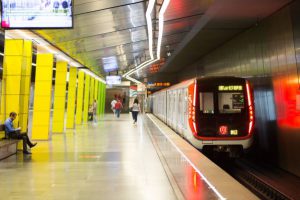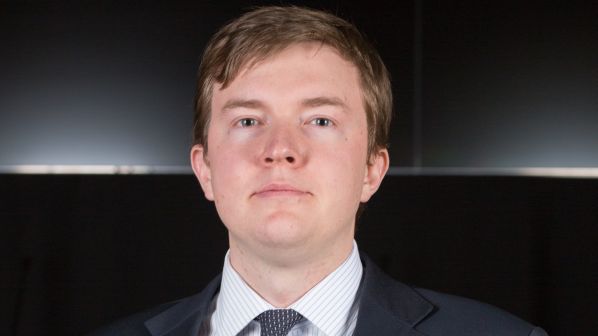KNOWN for its grand stations and impressive architecture, Moscow Metro is a busy operation transporting 8.5 million passengers daily. Accounting for 65% of all public transport journeys in a city of 12 million residents, more than half of the Russian capital’s population uses the sprawling - and growing - network.
The 440km system, already one of the largest in the world with more than 12,000 trains in operation every day and a peak headway of 90 seconds on several lines, is continuing to grow with services extending to new transport interchanges on the outskirts of the city to relieve pressure on central stations.
Of the network’s 261 stations, more than 70 were opened in the last seven years including two new depots and 15 stations on the Big Circle Line (Line 11 - BCL), Lublinsko - Dmitrovskaya Line 10 and Kalininsko-Solntsevskaya Line 8 in 2018.

“By 2020, 95% of all Moscovites will have stations within walking distance from their homes and offices, and for these reasons we expect the annual ridership to continue to grow,” says Mr Roman Latypov, Moscow Metro first deputy CEO of strategic development and client work.
“For example, in 2016 we launched operation on the Moscow Central Circle (Line 14 - MCC). By the end of 2018 the MCC is transporting more than 470,000 passengers every day while in 2017, daily ridership was more than 420,000.” The MCC is operated by Russian Railways (RZD) under a contact from Moscow Metro, with a unified fare system with the rest of the network.
Latypov says the 31-station BCL is currently Moscow Metro’s biggest project, and at 70km long, will be the longest orbital metro line in the world.
“The new circle will be used by about one million passengers daily,” Latypov says. “The first section of this line from Petrovskiy Park to Delovoy Tsentr opened in February 2018, and already transports about 80,000 passengers daily, which is 1.5 times more than the ridership during the first days after the opening. The full circle will be put into operation in 2023.”
The Solntsevskaya Line is also due to be extended to Vnukovo airport by 2023, making it the first airport in Russia with a direct metro connection.
“Connecting new stations to the existing network is organised during special technical shifts,” Latypov says. “For example, we closed only one metro station for the weekend to integrate Belomorskaya station into the Zamoskvoretskaya Line. Contractors work to a very tight schedule but we can’t leave our passengers without regular transport services.
“Complicated works are currently underway to integrate the Kozhukhovskaya (Nekrasovskaya) Line into the network. Here we are talking about the construction of an entire line and its connection to two sections to the network. The line is being built under the existing metro tracks. We will need more time and several technical shifts to cope with this task.”
While it continues to build new lines, Moscow Metro is also undertaking track renewals to improve the reliability of its network and replaced around 140km of rails and 17,000 sleepers in 2018.
Continuous welded rail has been used to reduce noise at stations, with a goal of installing it on more than 590 track-km by 2021.
Latypov says more than 40% of the fleet has been replaced with more than 1900 new cars since 2010, while the acquisition of another 1600 cars, due to be delivered by 2020, will push that figure to 60%.
Central to this renewal has been the introduction of the Moskva train, which was largely designed and built in Russia by Metrowagonmash and began operation in 2017 on the Tagansko-Krasnopresnenskaya Line, the network’s busiest line. It has since gone into service on the Kaluzhsko-Rizhskaya Line, another busy route.
The type 81-765/766/767 vehicles, which offer 15% more capacity than their predecessors, have USB charging points, interactive touch-screen route maps, full-width gangways and an upgraded HVAC system, while the driving cars have special areas for wheelchairs.
The bilingual passenger information system helps passengers locate stations, build routes and calculate trip times in both Russian and English. The LED interior lighting in the car adjusts automatically, from bright and cold in the morning to help passengers wake up, to warm and yellow in the evening to help passengers relax.
There are now 102 Moskva trains in service, and the fleet modernisation programme will continue in 2019. Under existing contracts, Metrowagonmash will provide Moscow Metro with 552 Moskva cars for use on the Tagansko-Krasnopresnenskaya and Kaluzhsko-Rizhskaya lines as well as sections of the network currently under construction.
A version of the Moskva adapted for surface operation is also in use on the Filyovskaya Line, which - unusually for the network - has large sections above ground.
Revenue growth
Steady growth in passenger numbers has resulted in an increase in fare revenue, which grew from Roubles 33.7bn ($US 505.9m) in 2010 to Roubles 57.4bn in 2017. Moscow Metro is also developing commercial services to generate non-fare revenue. These include promoting the network as a space to shoot advertisements and movies as well as leasing areas for shopping malls, which together generated Roubles 3.5bn in 2017, up from Roubles 1.9bn in 2010.
Subsidies allocated from the city budget have increased from Roubles 20.7bn in 2010 to Roubles 47.2bn in 2017, which includes Roubles 3.1bn towards studies required to develop the MCC.
The biggest challenge - and achievement - of 2018 was ensuring the network was able to cope while Russia hosted the Fifa World Cup, which saw an additional 300,000 passengers using the metro daily.
“During the days of the tournament our system became the main mode of transport for both citizens and football guests,” Latypov says. “We didn’t have any serious incidents or delays during this period. A lot of time, effort and money was invested in the modernisation of the whole transport system, including the creation of unified city navigation tools, the construction of new stations, constant maintenance of infrastructure, and the modernisation of rolling stock.”
Special turnstiles were also installed at 28 stations which enabled fans to use their RFID-equipped ID tags as tickets.
The passenger information systems on trains installed across the network, which showed the football games live during the tournament, have also been updated to show informative content produced by the Moskva 24 TV channel as well as information about each station, interchanges to other modes of transport, and schedule changes. The real-time information on the displays is synchronised with the official Moscow Metro mobile app, which has been updated to allow users to build routes and calculate trip times as well as top up travel cards and find sightseeing attractions. The app has now been downloaded more than 1.5 million times.
“We have equipped all stations with a contactless payment system,” Latypov says. “Moscow is home to 12 million inhabitants and is a destination for 21 million tourists annually. We understand that some of the Moscovites who use the system from time to time and the tourists don’t have the time and desire to study the fares and principles of our ticketing system in detail. Now, there is at least one turnstile at every station which allows them to pay for the trip using a bank card or smartphone.”
Moscow Metro has launched a project to renew signage and navigation aids, which includes creating a standardised style and providing more information in English, while stations are now equipped with maps of the surrounding area. New ATMs and vending machines have been installed at stations, while new shopping malls are opening in the entrance passages.
“We have also realised a big project dedicated to the entrance halls’ renovation,” Latypov says. “This year we finished main works on more than 50 stations. We made our entrance halls more convenient: renovated the stairs, installed more comfortable ramps and adapted infrastructure for the physically impaired.”
While the last few years have been a success, Latypov expects 2019 to bring its own challenges.
By the end of 2019 or at the beginning of 2020, the company is planning to launch two Moscow Central Diameters (MCD): existing main line tracks through the city which will be integrated with Moscow Metro and the MCC as part of a combined project between the Moscow Government, RZD and the Moscow Metro.
Moscow Metro is also planning to gradually move the departments responsible for traffic management to a unified operations control centre (OCC), and will begin testing a new ticket system at the end of 2019 which will allow passengers to use a personalised “Troika” card to control their account, block cards and transfer funds from one card to another.
Other goals for the year include reducing headways on the MCC from five to four minutes, as well as continuing rolling stock and station renewal.
“Moscow Metro is among the leading world metros in many indicators,” Latypov says. “These results are possible due to the professional work of 60,000 employees. In 2019 we will do our best to realise all current projects and develop new ones, to make the journeys on our network more convenient and pleasant.”

